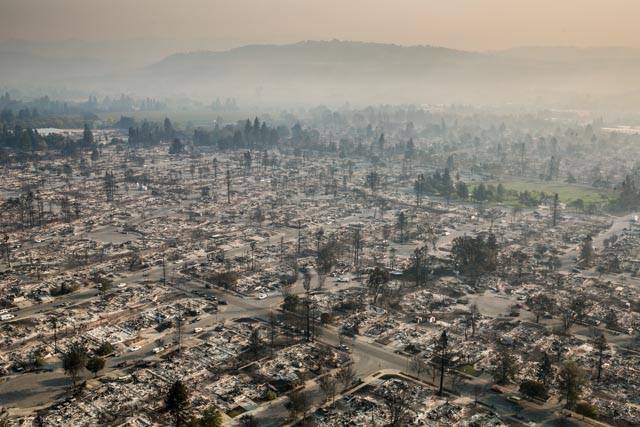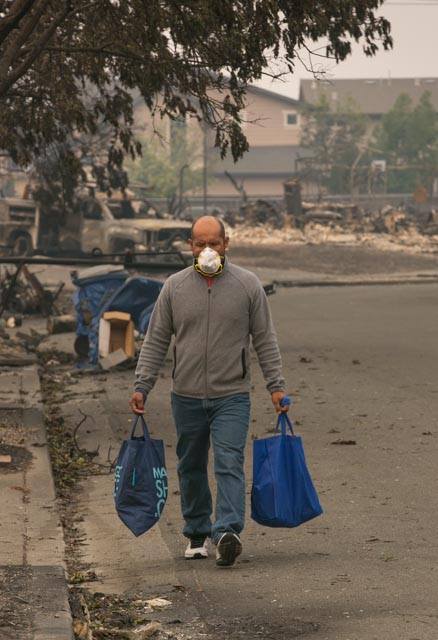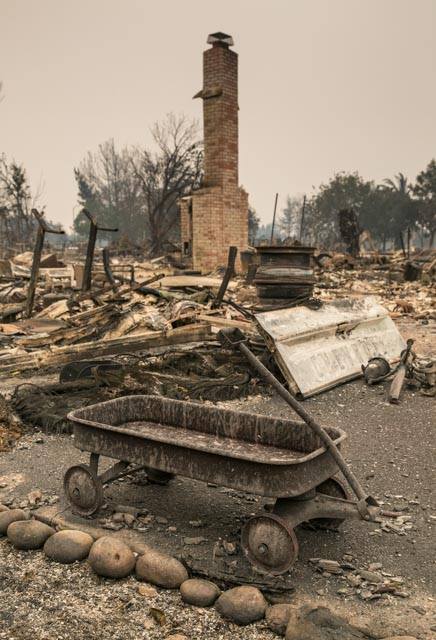Updates: As of noon on Oct. 12, the death toll has risen to 29. Acreage consumed has increased and fire is advancing on the town of Sonoma from the northeast. Fortunately, the fires' advance in some other areas has slowed and containment slightly better.

Photo Credit: George Rose
The wildfires ravaging Mendocino, Napa and Sonoma Counties remain officially uncontained. They have also spread into other counties. Collectively, the fires have consumed more than 90,000 acres of forest, agricultural land, businesses and homes. Twenty-one people are known dead with many hundreds injured and unaccounted for. More than 3,000 buildings are gone. Seven counties are affected in all. High winds are expected for tonight, which will make matters much worse. As of this morning, this complex of fires was already the worst in recorded Northern California history, surpassing the Oakland hills fire of 1991.

Entire neighborhoods have been destroyed. Photo credit: George Rose
Fire Acreage So Far
- Partrick fire (southern Napa County and Solano County) 9,500 acres, ≤2% contained
- Atlas Peak fire, Napa County, 42,000 acres, ≤2% contained
- Tubbs fire, Napa and Sonoma Counties 28,000 acres, ≤2% contained
- Nuns fire, Napa, 8,000 acres, 3% contained
- Redwood fire, Mendocino County, 32,000 acres, 5% contained
What's Happening Right Now
The various agencies fighting the fires are now trying to control the fires’ perimeter when possible and have also saved individual buildings here and there. However, the primary goal remains protecting human lives. Evacuation zones are still in effect and are being expanded in some areas. Fortunately, the strong, hot winds—above 60 miles per hour in some places— abated late yesterday and today.
Fire fighting management reports that a record 266,000 gallons of retardant had been dropped by air as of yesterday afternoon. More than 45 missions had been flown from a single airport. Seven massive loads were dropped by a 747. The air efforts continue, but are made difficult by temperature inversions which affect flight and also dispersion of retardant. Some firefighting crews have worked 48 hours straight. There are 8,000 firefighters in action throughout the state.
The California Highway Patrol has more than 100 officers assigned to the fires, mostly working traffic control and enforcing road/off-ramp closures. Many major thoroughfares remain closed. Highway 101 is now open through Santa Rosa, but a number of exits are still closed.
The California National Guard is working at shelters and getting fuel and supplies to first-responders. Later today, they will be working to restore communications. They will also deploy unmanned aircraft to provide better intelligence on the status of the fires.
More than 3,200 people are in shelters throughout the affected areas. As many as 20,000 people overall have taken refuge with friends, in hotels or have left the area entirely. Electricity and cell towers have been greatly affected, which hampers communications, means gas stations are not able to operate, etc. Water quality was also impaired in some neighborhoods and those people who remain in the area have been told to boil it before drinking.
Just moments ago, the entire town of Calistoga was put under a mandatory evacuation order. Police are going door-to-door. Small towns in Sonoma Valley, such as Agua Caliente, are under "advisory evacuation" orders. Portions of Fairfield are under advisory evacuation too. Residents in some areas of Healdsburg are waiting to see if they are next.

For many, the remains of their possessions won't fill two bags. Photo credit: George Rose
Causes
The cause of the various fires is under active investigation. It’s too early to reach any conclusions and the primary focus is still on preservation of lives and control of the fires. That said, initial indications are that downed power lines were a key factor.
Much of California and, as we’ve seen in recent weeks, the west coast, has become a tinder box. Years of drought have had a lasting effect. The recent, normal-to-heavy rains encouraged growth of underbrush which, in the dry, hot days of August through September, became ready fuel for the smallest spark. Extremely low humidity, hot air—it was 96 degrees in Russian River Valley when I was there Sunday afternoon—and high winds made the situation explosive and the spread of fire incredibly fast. Some people, who thought themselves safe, suddenly had just five minutes to escape.
Danger exists outside of the immediately affected areas too. The East Bay, for example, is extremely dry and any spark, be it a floating ember or a dropped cigarette, will cause a conflagration. In the meantime, the San Francisco Bay Area overall is extremely smoky.
Effect on Wineries
People want to know the status of various buildings, wineries and their homes. That information is hard to come by. Buildings, once burned, are hard to identify in photos. With the demise of landmarks and street signs, entire neighborhoods become unidentifiable. And some structures, surrounded by flames, seem sure to be destroyed but survive nonetheless.
So far, the only wineries I can absolutely confirm as destroyed are Signorello Estate in Napa Valley, Frey Vineyards (America's first organic and biodynamic winery) in Redwood Valley, Paradise Ridge (in both Santa Rosa and Sonoma Valley it seems), and perhaps Golden Vineyard and Oster Wine Cellars in Mendocino County. Others, which were initially reported destroyed, such as Darioush, James Cole, William Hill, Stags Leap Winery, Domaine Carneros, Nicholson Ranch, and Gundlach Bundschu, may have sustained some damage but are mostly intact at last report. Adam Lee of Siduri Winery was stunned to find the entire industrial park in Santa Rosa where he and many others make wine was completely intact, the fire having stopped one block away after razing the surrounding neighborhoods.
Some wineries which made it through benefitted from large parking lots or vineyards which acted as firebreaks, or were simply “lucky.” Others were saved through concerted, heroic efforts by firefighters, staff and neighbors.
The status is simply unknown for many wineries. Owners are unable to get to the properties. Beyond the winery buildings though, there has been substantial damage to vineyards. And many winery employees and proprietors know they have lost their homes. It will take days for the full toll to be known and a very long time for things to get back to what will pass for normal.
All of this comes in the midst of harvest. And harvest has continued, as possible and with breathing protection due to smoke, in those vineyards not currently in evacuation zones.
Of course, once grapes are picked, they need to be vinified. That process is hugely complicated by lack of power. Large, windowless production rooms may be pitch dark. Sorting tables, crusher/destemmers and presses sit idle unless solar power or liquid-fuel generators are available. Likewise, cooling of fermentation tanks is problematic. Aaron Pott, speaking of his work today at Quixote Winery in the Stags Leap District, said he was brushing up on his “18th century winemaking techniques.”
The wineries are also dangerous. Fermentation releases large amounts of carbon dioxide. If the electric vent fans are not working, the concentration of CO2 can render people unconscious, then dead, in seconds.
Fortunately, power is gradually coming back in some places. Despite that and the fact that many wineries are operating from a production and management standpoint, it’s safe to assume they are not open for consumer business today or tomorrow. The typical message, such as that from Opus One, is that they are “closed until further notice, check the website/Facebook page for updates.”
What You Can Do

This fire is much more about families than wine and wineries. Please help. Photo credit: George Rose
For now, lovers of the amazing wines of these regions should stay off the roads, give their lungs a break and consider helping by donating to shelters, reputable GoFundMe pages and other charitable concerns. I have contributed to this one. Other ways you can help include:
Petaluma People’s Services Center will be arranging for Emergency Home Shares in Sonoma County. Persons willing to host an evacuated individual or family in your home for a few days, few weeks or few months may contact PPSC SHARE Sonoma County at SHAREfire@petalumapeople.org. An information sheet and application will be sent to you immediately.
Persons seeking short term temporary shared housing may contact SHAREfire@petalumapeople.org, for more information and an application, or contact PPSC 707-765-8488.
Persons interested in donating items for the fire victims may do so beginning Tuesday morning at the Lucchesi Community Center on McDowell Boulevard, the Sonoma Marin Fairgrounds on East Washington Street. Donations May also be brought to the Petaluma Grocery Outlet Store on Tuesday.
Donate or volunteer with the Red Cross or food banks in the affected towns.
The Napa Valley Community Disaster Relief Fund is collecting cash donations here.
Local animal shelters, which are helping people keep their pets safe, need help too. Humane Society of Sonoma County: sonomahumane.org, Humane Society of Napa County: napahumane.org, and Yuba-Sutter SPCA: yubasutterspca.org.
My friend Tom Smith is leading worthy fund-rasing efforts too. Click on his names to access it.
The Livermore Valley Winegrowers Association is taking donations which will be passed on to Napa and Sonoma. You can see a list of participating wineries on their blog.
Staying Up to Date
I am posting frequent, public updates on Facebook. You can find them here.
Thank you for the amazing photos, George Rose
George is an award-winning photographer doing a tremendous job of capturing the unfolding tragedy. Please support his work.
JJ Buckley guest blogger Fred Swan is a San Francisco-based wine writer, educator, and authority on California wines and wineries. His writing has appeared in The Tasting Panel and SOMM Journal. Online, he writes for his own site, FredSwan.Wine (formerly NorCalWine), PlanetGrape, and GuildSomm. He teaches at the San Francisco Wine School. Fred’s certifications include WSET Diploma, Certified Sommelier, California Wine Appellation Specialist, Certified Specialist of Wine, French Wine Scholar, Italian Wine Professional, Napa Valley Wine Educator and Level 3 WSET Educator. In 2009, he was awarded a fellowship by the Symposium for Professional Wine Writers. In that same year, he was inducted into the Eschansonnerie des Papes, the honorary society of the Chateauneuf-du-Pape AOC.